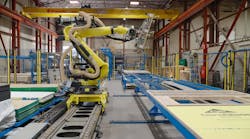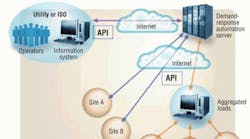According to the U.S. Department of Energy (DOE), 27 states and the District of Columbia have a renewable-portfolio standard—a policy requiring electricity providers to obtain a minimum percentage of their power from renewable-energy resources by a certain date—while five states have nonbinding goals for adoption of renewable energy (http://bit.ly/RPS_DSIRE). In those places, interest in demand response (DR) is growing.
DR is a set of activities to reduce or shift electricity use in response to supply conditions, with the goal of improving electric-grid reliability and managing customer electricity costs. Automation helps to improve the performance of DR programs by allowing responses to be more repeatable and reliable.
This article discusses Open Automated Demand Response (OpenADR), an information-exchange specification developed by the Demand Response Research Center (DRRC) at Lawrence Berkeley National Laboratory that enables fully automated DR. OpenADR uses utility-provided price, reliability, or DR-event signals to trigger preprogrammed energy-management strategies automatically.1
This article also discusses the ancillary-services market. Ancillary services support power systems by helping to maintain power quality, reliability, and security. In California, California Independent System Operator (CAISO) purchases four types of ancillary-service products: regulation up, regulation down, spinning reserve, and non-spinning reserve.
Lastly, the article discusses pilot studies in which facilities participated in retail DR programs and wholesale ancillary-services markets and identifies research needed for widespread adoption of this approach.
OpenADR
OpenADR consists of two parts: a demand-response automation server (DRAS) and a DRAS client, also known as an OpenADR client (Figure 1).2 Hosted by a utility or independent system operator, the DRAS publishes signals that notify an electricity customer of DR events. Embedded in or connected to the customer’s building-control system, the DRAS client listens to the signals, initiating preprogrammed control strategies in response.
Ancillary Services
Regulation energy is used to control system frequency, which can vary as generators access a system. Generators must respond to automatic-generation-control (AGC) signals to increase or decrease their operating levels, depending on the service—regulation up or regulation down—they provide.
Spinning reserve is unloaded capacity of units connected to or synchronized with the grid that can deliver energy in 10 min and run for at least two hours. Non-spinning reserve is capacity that can be synchronized and ramp to a specified load within 10 min. Typically, resources are dispatched using the International Organization for Standardization’s automated dispatch system (ADS) in conjunction with an energy-management system.
Participating-Load Pilot
CAISO offers two programs for participation in the wholesale DR market in California: proxy demand response (PDR) and participating load (PL). PDR is a load or aggregation of loads capable of measurable and verifiable electric-energy-demand reduction. These resources submit bids to the wholesale day-ahead or real-time energy market and respond to CAISO dispatches. Verification is done using a 10/10 baseline (average load over the previous 10 eligible days) or an agreed-upon baseline for a direct-load-control-type program. PL is a load that can only provide non-spinning reserve and curtail loads through real-time-market dispatch. With PL resources, hourly forecasts of bids are used for verification.
In 2009, the DRRC worked with CAISO to place three automated-DR customers from retail markets in the PL program. The customers’ communication and controls infrastructure was unchanged. The results showed that individual facilities can meet PL requirements with the same DR strategies used for retail-DR-program participation.3
Figure 2 shows the architecture used to connect the three sites to CAISO's signals. The ADS dispatched DR resources through the DRAS. For awards dispatching, OpenADR messaging infrastructure was utilized to deliver DR signals to the facilities’ energy-management and control systems (EMCS).
Dual-meter-socket installations allowed the facilities to keep their revenue meter and facilitated the installation of a meter with a code-division-multiple-access (CDMA) chip for the transfer of electric-load data. CDMA technology transmitted radio signals over a cellular-based wireless network. Four-second telemetry infrastructure was installed at each facility, and data were communicated to CAISO, the DRAS, and the utility. CAISO used the data to make the operating reserves visible on the grid and to ensure the resource was meeting its minimum operating-reliability criteria at all times. The utility stored the telemetry and interval-meter data in a secure folder. The data were used for load and shed forecasting.
The DRAS used the data to dispatch preprogrammed control strategies to sustain the shed amount dispatched by CAISO.
Having participated in the utility's automated-DR program for at least two years, the facilities already had two-level DR strategies programmed into their EMCS. The operators of each facility were asked to re-evaluate their strategies and decide for how long and with which DR strategy they would participate.
The operators of one facility allowed the team to adjust DR strategies based on the load feedback received from the 4-sec telemetry. A DR strategy utilizing 4°F temperature-set-point adjustments with 1°F increments was preprogrammed into the EMCS. During the resource-request period, forecasted bid level (target shed level) and measured load shed (current load level) were compared, and adjustments to temperature set points were requested automatically to sustain forecasted bid levels. Figure 3 shows how target shed level was maintained using measured sheds.
Results of the tests show:
- HVAC as an end use and global temperature adjustment as a DR strategy meet the 10-min-response-time and two-hour-duration requirements for wholesale ancillary services.
- OpenADR can be used to communicate wholesale DR events in an open and interoperable manner. From a customer’s perspective, the transition from automated DR to PL was seamless. The same infrastructure was used, with no additional costs.
- The Internet can be used for fast DR to dispatch non-spinning ancillary services and still meet a 10-min load-response time.
Load as Regulation Product
In 2011, the DRRC began work to automate the responses of three additional customers for participation in CAISO regulation-up and regulation-down products (Figure 4).
CAISO publishes load-instruction set points and communicates with the DRAS through a private network using the Inter-Control Center Communications Protocol (ICCP) over the energy-communications network (ECN). The DRAS pushes those signals to the customers' DRAS client every 2 sec. Data are collected using the same infrastructure used in the 2009 pilot. Telemetry data are stored in the meter-data-management (MDM) database and communicated to CAISO through the private-network channel so that the resources are visible to CAISO.
The DRRC is finalizing tests that include the demonstration and evaluation of ramp rate, DR amount, and communication latencies. It plans to publish its work in 2012. To date, it has identified the following areas in need of further research:
- Characterization. Generators are characterized by constant quantities, such as operating limits and ramp rates. Commercial and industrial facilities cannot be characterized accurately that way, as operating limits and ramp rates vary by season, outdoor temperature, occupancy, and other variables.
- Predictive models for and approaches (technical and economic) to determining the degree of compliance with promised behavior. Determining whether conventional generators have met their promised ramp rate and capacity numbers is a simple matter of measuring how much power they delivered as a function of time. For commercial and industrial facilities, however, actual load must be compared to some sort of load forecast or prediction, which typically is imperfect.
- System setup. Enabling all of the necessary systems for the pilot project has been harder than expected. Even with skilled and motivated participants at each of the pilot sites, there have been time-consuming problems with installing metering, installing control hardware, programming automated responses to CAISO signals, and so on. A conventional generator has only one job—to generate power—and the entire facility and its staff are optimized for that purpose. A facility is designed for completely different purposes.
Conclusion
Wider adoption of DR for ancillary services will require further study of:
- Standard methods of characterizing DR. DR characteristics vary according to end use, system, operation, season, day of the week, time of day, and more. A framework for representing DR characteristics year-round is required for both demand-side and supply-side stakeholders. An extensive characterization of facility end use would greatly benefit any effort to use DR as a regulation resource.
- Processes for DR for participation in regulation. A generator typically is tested, characterized, and certified for participation in regulation. DR is a more dynamic resource that cannot be characterized with a one-time test. Either the resource should be tested for a wide range of participation conditions (season, day of the week, time of day) or estimation methods have to be developed so that the resource can be characterized. Statistical and physical models can greatly improve estimations and reduce the need for tests.
- The interaction between AGC logic and DR. How DR resources interact with CAISO’s AGC system can be examined only if sites actually are placed in the ancillary-services market. Further research with larger loads is needed.
- The role of aggregation. Aggregation may enable smoother transitions between set points, as an increasing number of discreet steps better approximates continuity. Aggregation also enables probabilistic treatment of participants and may simplify management of the variability associated with load and DR.
Acknowledgements
The work described in this article was sponsored in part by the DRRC, which is funded by the California Energy Commission’s Public Interest Energy Research program and the DOE.
References
1) Piette, M.A., Watson, D., Motegi, N., Kiliccote, S., & Linkugel, E. (2006, April). Automated demand response strategies and commissioning commercial building controls. Paper presented at National Conference on Building Commissioning, San Francisco, CA. Available at http://peci.org/ncbc/proceedings/2006/BF2_Piette_NCBC2006.pdf
2) Kiliccote, S., Piette, M.A., Dudley, J.H., Koch, E., & Hannage, D. (2009). Open automated demand response for small commercial buildings. Berkeley, CA: Lawrence Berkeley National Laboratory. Available at http://drrc.lbl.gov/sites/drrc.lbl.gov/files/lbnl-2195e.pdf?q=pubs/lbnl-2195e.pdf
3) Kiliccote, S., et al. (2009, November). Open automated demand response communications in demand response for wholesale ancillary services. Paper presented at the Grid-Interop Forum, Denver, CO. Available at http://drrc.lbl.gov/system/files/lbnl-2945e.pdf
OpenADR Alliance
OpenADR Alliance (www.openadr.org) was formed in 2010 to accelerate the development, adoption, and compliance of OpenADR standards throughout the energy industry. A newer version, OpenADR 2.0, is under development as a profile under OASIS' (Organization for the Advancement of Structured Information Standards’) Energy Interoperability technical committee. OpenADR 2.0 will be finalized in the fall of 2011, with the first certified products available by the end of 2011.
Sila Kiliccote is a program manager in the Building Technologies Department at Lawrence Berkeley National Laboratory (LBNL) and deputy group leader of the LBNL-led Demand Response Research Center (DRRC). Her areas of interest include characterization of building loads and demand reduction, demand-responsive systems, building-systems integration, and feedback for demand-side management. She has a bachelor’s degree in electrical engineering from The University of New Hampshire and a master’s degree in building science from Carnegie Mellon University. Mary Ann Piette is the head of the Building Technologies Department at LBNL and director of the DRRC. She is a member of the National Institute of Standards and Technology Smart Grid Architecture Committee and the recipient of several awards related to programs to automate demand response, as well as the Benner Award for contributions to making building commissioning “business as usual.” She has a bachelor’s degree in physical science and a master’s degree in mechanical engineering from the University of California, Berkeley, and a licence in building-services engineering from Chalmers University of Technology in Sweden.
Did you find this article useful? Send comments and suggestions to Executive Editor Scott Arnold at [email protected].













